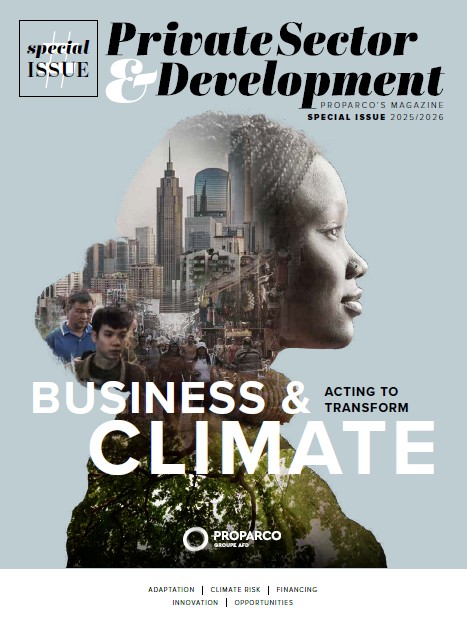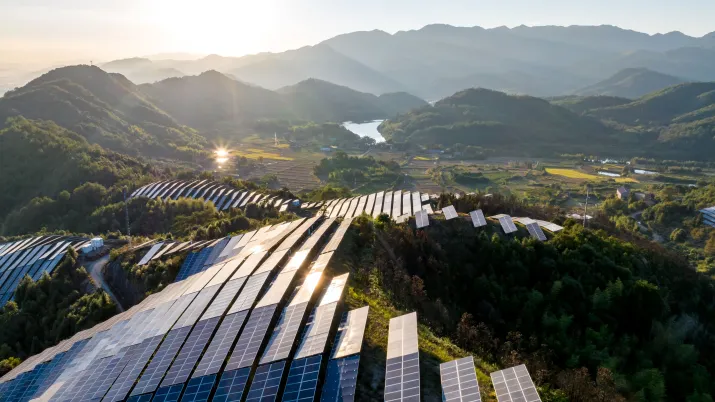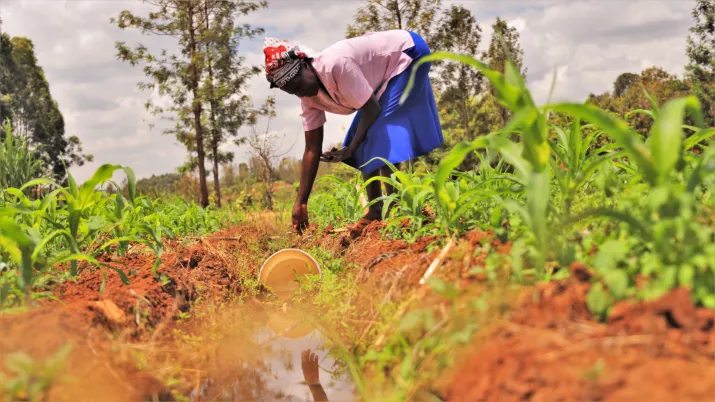Share the page
How emerging countries innovations can scale climate resilience for all
Published on
Fernando J. Díaz López Executive Director Centre S&O Climate & Earth, HEC Paris


Private Sector & Development - Business & Climate: Acting to transform
Proparco has published a new edition of its Private Sector & Development magazine, focusing on the strategic role of the private sector and financial institutions in tackling the climate emergency.
A new paradigm of global development has emerged – the climate resilience transition – requiring climate resilient solutions. While DFI and DAA are supporting these, they may not fully capture the market opportunities that climate resilience represents. Hence, the considerable opportunity for private action remains largely underexplored, and its transformational power is poorly understood. Yet, despite the challenges (economic and regulatory), the emerging countries is stepping to the fore.
Floods, heatwaves, storms, droughts, forest fires – the daily news constantly reminds us that the climate has changed. Greenhouse emissions continue to rise, with devastating socio-economic consequences. Societies and economies need to adapt decisively and fast – and many solutions for mitigation and recovery are readily available.
Amid the climate turmoil, a new paradigm of global development has emerged – the climate resilience transition. For the past decade, International Development Finance institutions (DFIs) and Development Aid Agencies (DAAs) have been called upon to play a key role in the mainstreaming of solutions for climate mitigation and adaptation.
When discussing climate resilient solutions, we refer to new technologies, products, services and business models used to anticipate, absorb, adapt and transform systems related to climate impacts (risks, hazards, vulnerability). To the surprise of many, a considerable number of these are emerging across Africa, Latin America and the Caribbean, the Middle East and SouthEast Asia.
Climate resilience for development portfolios: supporting emerging countries solutions
In recent years, DFIs and DAAs have been proactively launching climate resilience for development initiatives, in an attempt to manage the climate challenge. Across the globe, many international actors are implementing climate adaptation and climate risk projects at different scales – e.g. providing funding, financing (including blended finance) and guarantee financial mechanisms. Thematically, these programmes address issues related to adaptation planning, disaster response, nature-based solutions, reduction of inequalities, capacity building, infrastructure development, among others. Examples of the above include the UK PACT, the AFD’s AdaptAction, FMO’s Dutch Fund for Climate and Development – to name but a few.
DFIs and DAAs are also catalysing private investments and creating market opportunities for emerging countries innovations in climate adaptation and resilience. For instance, the InterAmerican Development Bank has launched CLIMA – a performance-based, financial mechanism that rewards borrower countries when nature and climate KPIs/objectives are met (with a 5% rebate). Proparco has also implemented similar Sustainability-linked Loan initiatives. For example, it has led a group of DFIs in a historic loan to EcoBank that is linked to two major climate commitments and diverse criteria of sustainability performance.
However, despite their manifold and tangible benefits in increasing climate preparedness, traditional climate resilience development programmes are likely to lag in standard mechanisms of technology transfer. Moreover, they may not be able to fully capture the market opportunities that climate resilience represents.
The climate adaptation finance gap is smaller than the resilience market opportunity
As noted in a previous article in Private Sector & Development, Proparco’s magazine, there is a real climate resilience market opportunity. The Climate Policy Initiative (CPI) has estimated that USD, 6,7 trillion in annual climate finance will be needed during 2024-2030. An additional 7 trillion will be needed annually in the period 2031-2050 (about USD 14 trillion by 2050). However, and understandably so, a vast amount of the finance available is spent on climate mitigation and decarbonisation (mainly renewable energy projects). According to CPI estimates, less than 5% of climate finance is spent on adaptation and resilience. Moreover, the adaptation finance gap is estimated to be around USD 320-400 billion per year by 2035 (about USD 3.2 - USD 4.2 trillion).
Because of the existence of dual gaps in climate finance (general and adaptation finance), it is possible to talk about a considerable market for climate resilience solutions. Specialised market firms suggest USD estimates of 10-100 bn by 2030 (e.g. by Fortune Insider, SNS insider). A recent study by the investment firm Tailwind suggested that the market for climate adaptation and resilience solutions is in the order of 1.4 trillion a year. According to this source, the global demand in USD for adaptation and resilience solutions in 2023 was 737 bn from governments, 647 bn from consumers, and 58 bn from corporates (both in the global north and south). A vast percentage of this demand is set for agriculture, food and forestry (491 bn), water sanitation (387 bn), infrastructure (213 bn) and cities and settlements (160 bn).
The Global Adaptation Commission (GAC) forecast that annual investments in USD in adaptation measures of 1.8 trillion globally from 2020 to 2030 could generate 7.1 trillion in total net benefits (from early warning systems, climate-resilient infrastructure, improved dryland agriculture, mangrove protection, and water resource resilience). The World Resources Institute (WRI) recently estimated that every 1 USD of investment in climate adaptation (agriculture, water, health and infrastructure) translates into 10.5 USD of added value (benefit) over 10 years. This means that in USD terms, 133 bn of investments could generate 1.4 trillion.
The evidence suggests that investing in climate adaptation makes good economic sense; hence, there is a business case for climate resilience solutions. However, not all solutions are visible to global investors (e.g. insufficient datasets, indicators, etc). Because of this, the current scope and depth of private action in climate resilience remains largely underexplored, and its transformational power is poorly understood.
The transformational power of climate resilience solutions from the emerging countries
In April 2024, devastating flash flooding affected the city of Nairobi, Kenya. According to the Kenya Red Cross, this extreme climate event resulted in over 290 people dead, numerous businesses, and many hectares of land and households affected (over half displaced). UNDP estimated its effects in USD at 671 million of losses and 783 million in damages. It could have been worse had a series of climate resilience solutions not been timely implemented. These measures included early warning systems and SMS alerts, digital crowdsourcing and crisis mapping platforms, community-based local response networks (combined with on-the ground support by the Red Cross Society, Islamic Relief, and other organisations), and pre-emptive use of nature-based solutions (around the Mau Forest Complex and the Aberdare Range).
On October 29, 2024, one of the most devastating climate events in Europe took place in the Valencia region of Spain. According to the Valencian Institute of Economic Research, the ‘DANA’ flash floodings resulted in the deaths of 228 people, the displacement of thousands of people and hectares of land affected.
Economic losses in EUR were estimated to be in the order of 12-50 billion. While the City of Valencia also relied on an early warning system, SMS messages, on-the ground support (Civil Protection and Military Emergency Units), it did not effectively rely on crowdsourcing platforms such as Ushahidi (developed in Kenya and used during the Nairobi floodings). Another interesting element was the use of European satellites and on-the ground sensors in Nairobi, originally instated as part of the Horizon Europe project TWIGA. In Valencia, part of the recovery plan now includes a strong focus on nature restoration. This comparison serves to illustrate how emerging countries innovations can make a difference – including in combination with climate resilience solutions from the global north.
There are a growing number of emerging countries climate resilience innovations that are being successfully exported to the Global North. A remarkable example is Ushahidi. This social enterprise was created in 2008 as an open-source digital platform to monitor post-electoral violence in Kenya. It has since evolved into a series of interconnected digital services and platforms, providing real-time, crowd-sourced data that generates situational awareness maps used for rapid emergency responses in extreme climate events. Examples of other events where this technology has been used include Japan’s earthquake and tsunami (2011), Atlanta’s snowstorm (2014), and the Pakistan floodings (2022). Headquartered in the USA and Kenya, it is a long-term partner of UNDP across many international projects – having acquired global recognition. Ushahidi has received funding from UK Aid, US Aid, the Omidiyar Network (USA) and others; it has many international public and private clients (public authorities, newspapers, NGOs).
Its latest project, Gearbox! has been funded by the Lemelson Foundation and is supported by MIT. Gearbox! is a 10,000 m 2 open-innovation ecosystem facility for design and rapid proto - typing. Outside Africa, additional examples of emerging countries innovations in inter - national markets include India-based Cropin (AI for regenerative agriculture), Saudi Arabia’s Sadeem Technology (flood and traffic infor - mation smart system) and Mexico’s Gravalock (permeable floor / street systems) – all with clients in Europe, the USA and Canada.
Additional examples are Jokalante, a Senegalese social enterprise offering an early warning system and local-language radio support for fishermen and farmers, and Rada360, a Tanzanian precision agriculture solutions venture, combining precision irrigation sensors, satellite-based crop monitoring, and soil testing. It remains to be seen, though, whether their local ecosystems will give them the conditions to upscale.
Many other climate resilience solutions have similar potential for a wider applicability. The specialised data platform NetZero Insights reports close to 5200 startup companies active in the climate adaptation and resilience space (climate risks, climate monitoring, environmental disaster management, water, nature-based solutions, resilience agriculture). These companies – approximately 40% of which are located in the emerging countries – have leveraged USD 29 bn of venture capital funding (pre-seed, seed, early stage, late-stage VC).
Climate resilience ecosystems in the emerging countries, the missing piece
As shown by the above examples, innova - tive climate resilience solutions can be adopted (diffused, transferred, exported) following regular market dynamics – regardless of where they originated. However, new solutions, ventures and business models are more likely to emerge in well-structured and functioning innovation ecosystems. In weaker or less mature ecosystems, governments (and their implementing bodies) must intervene to correct market and systemic failures – especially when economic and regula - tory forces do not reward novel solutions (more commonly present in the emerging countries). An ecosystem-based approach to supporting climate resilience hubs of innovation and experimentation might be the missing piece to mainstream climate solutions.
A variety of climate innovation for develop - ment programmes are emerging to identify emerging countries innovators, strengthen local ecosystems, remove barriers to scaling, and promote systemic innovation, experimentation, and learning. One example is UNDP, which leads the global adaptation innovation market - place (AIM) and the Adaptation Fund Climate Innovation Accelerator (AFCIA). Another is UNIDO, which is executing a GEF-funded programme that includes a Community of Practice on Micro, Small and Medium-sized Enterprises (MSMEs) Incubation and Acceleration. DFI and DAA are also partnering with intermediary and academic organisations to achieve similar missions.
Academic institutions are also supporting climate resilience in the emerging countries. For example, the HEC Paris Challenge+ Africa programme is supporting innovators in Dakar and Abidjan – with the support of the French Ministry of Foreign Affairs. This programme focuses on strategy, investment readiness, business models and business planning, supporting ventures such as Jokalante, Limawa, and Soltima, among others.
Further reading
Sustainable finance in action: when financial players transform their business model
Published on November 20 2025
In Sub-Saharan Africa, the ARAF fund is strengthening the climate resilience of smallholder farmers
Published on November 12 2025
Where climate risk meets opportunity: how Ecobank is financing Africa’s future
Published on November 6 2025




